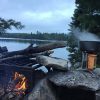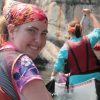Paddling on Route 66
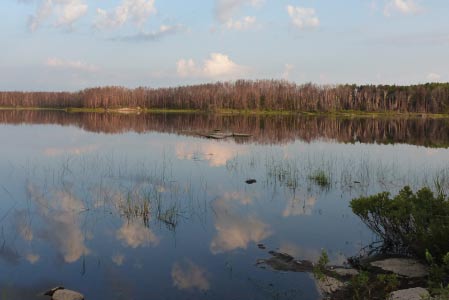
Boundary Waters Calm. All photos by and courtesy of Norma Christianson.
by Larry Christianson
Paddling season arrived for me with great personal meaning as this is the time where I planned to catch up to my age in the sense of arriving in autumn at boundary waters canoe trip number 66 at age 66. A long-term goal that has been lurking out there on my life horizon—defining the theme for this year 2014 as “Paddling on Route 66.”
I feel like a relic. An old guy still able to paddle and portage and sleep in a tent and catch fish and enjoy wilderness canoe trips. I can hardly drive a car anymore, yet can paddle with strength and confidence. All very ironic. Another good example of going the unhurried way with more enjoyment and meaning. The lure of wild places remains firmly embedded in my heart, even though at a slower pace and different style in the midst of mounting limitations and declining health. Just being on scene in the boundary waters matters to me big time. Drinking in the beauty along with morning coffee and evening happy hours, and all the relaxing stretched in between.
In reading Paddling to Winter by Julie Buckles, I learned about “duff days”—those much needed days of rest and renewal in camp. And it dawned on me that back in my younger days, duff days were not always welcome. They were seen as a necessary inconvenience for avoiding the dangers of high winds, thunderstorms or lightning strikes, and for accomplishing basic camp tasks. But top priority was being in a canoe on the water, paddling and portaging to surrounding lakes, fishing sweet spots beckoning from the map, picnicking at memorable places from past trips, exploring more and more beauty of the boundary waters. Since significant health issues started in my late forties, occasional duff days became a very important part of a new physical reality. Now in my older years, they are an essential ingredient in remaining fit and able to enjoy wilderness canoe trips. And I have come to really appreciate our duff days as some of the best days. A change of attitude as well as style.
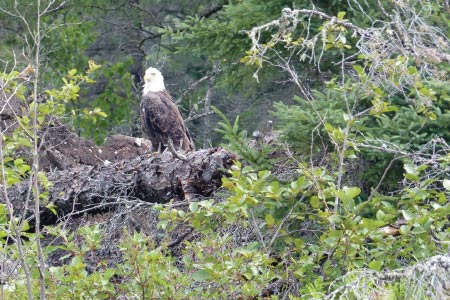
Eagle Eyes.
Paddling on Route 66 all the way to catching up with my age has been a goal pursued with increasing fervor as the years slipped by. Factors involved include maintaining a reasonable measure of strength and fitness; the desire to keep on paddling and portaging; trusted and willing companions; lighter weight camping equipment and canoes; eating less and lower on the food chain; scaled back expectations; retiring from the work world. More flexibility and freedom in the spirit of going slower and enjoying it more.
In a spin of serendipity, my trip number 66 appeared suddenly in a spur of the moment opportunity to take the place of three women who were lined up to be going to the boundary waters with my wife and longtime paddling partner Norma. They all cancelled within a few hours span of time, each for separate and solid reasons. So with forty hours before departure for Ely, Norma asked if I wanted to go along on her canoe trip. An intriguing question which proved to be a good test for my often-stated claim “to be ready to head for canoe country on a one hour notice.”
Maybe not literally, but not far off the mark as I grabbed fishing poles, scrambled to pack clothes and added my sleeping bag and pad to Norma’s already assembled packing pile. We worked together to re-group food from four people to us two pescatarians, and arrived in Ely at Canoe Country Outfitters not forty-eight hours later.
Entry day was grand—warm air, calm water and light breezes—and a new camping destination in mind. The east end area of Lake Four. My old misty moose camp with friend Tom from back in 2000 was a real treasure in its vacancy. It is a first-time campsite for Norma, and we easily settled in to relax mode.
Our exploring included a memorable visit to nearby Picnic Rapids, which we could hear in the night as a Lake Four lullaby—humming, singing softly in melody for weary campers sleeping peacefully. The forest surrounding the rapids and along the short portage on the way deeper into the wilderness was completely burned in the Pagami Creek Fire we had escaped. For us the area is a sobering reminder of that smoky orange full moon night of danger nearly three years past, but still very fresh in our memories. New growth is an incredible witness to forest renewal and the resiliency of creation, as well as the relentless reality of destruction. A living laboratory offering countless science lessons for decades to come.
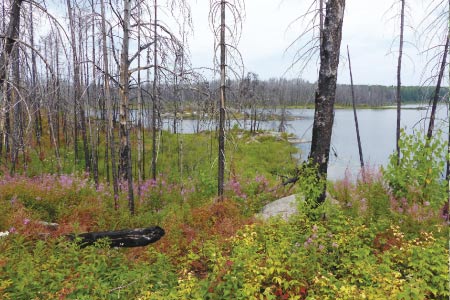
Pagami Creek Fire Forest Renewal, Lake Four.
We finally ventured into the north arm of Lake Four. After all our times in Kawishiwi country through the past three decades, we never bothered to paddle into the narrow, rocky channel seldom explored by campers. Out of the main numbered lakes traffic flow, the north arm is more secluded and feels wilder.
in fascinating sights of new growth pine and aspen, purple expanses of flaming fireweed and numerous varieties of other weeds already thick and chest high. Abundant patches of sweet raspberries invited us to enjoy a quick snack. Rocks burned black and dead trees standing, leaning and lying in tangles of destruction filled out a scene stark in panoramic view. All sprinkled with splashes of beauty offering glimpses of a hopeful forest future lurking far out on time’s horizon, but certainly not in our lifetimes.
A weariness hard to describe surfaced within me in the waning hours of each day. Too much sun. Too much humidity. Too much dealing with buzzing critters. Maybe even too much relaxation. All I know is fresh air and round-the-clock outdoor living are both tiring and invigorating. Aging takes its toll on my body as my spirit feels young and vigorous. Like James Garfield wrote in his presidential diary in 1881: “If wrinkles must be written upon our brow, let them not be written upon the heart. The spirit should not grow old.”
The weariness comes with the special bonus of better quality sleeping in a tent. All the tossing, turning and adjusting of positions of younger years have evolved into conking out fast with a peaceful evening of rest. Not even interrupted by night noises of a lively forest and moving lake water. Only by an inevitable biffy call.
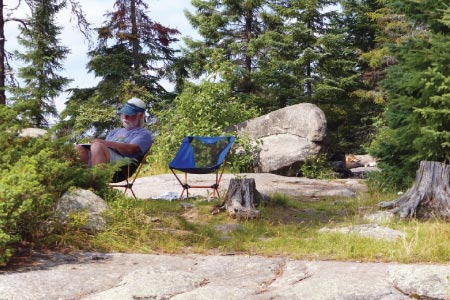
Duff Day, Larry Christianson.
Our last day before paddling in to Lake One landing and claiming the culmination of my long-time goal was a very relaxing duff day. A wonderful oasis along Route 66. My reflections circled around to Shell Lake and my inaugural boundary waters canoe trip in 1975—long ago and far away in terms of expertise and experience. Enough love for wilderness experiences must have seeped into my heart to keep me returning to canoe country as a deeply meaningful part of my life journey.
Arriving at my personal Route 66 is a landmark event for me in this same year as the 50th anniversary of the passage of the Wilderness Act in 1964. Congress created a national preservation system for designated wilderness areas—which included the Boundary Waters Canoe Area—and established the following legal definition of wilderness: “A wilderness, in contrast with those areas where man and his own works dominate the landscape, is hereby recognized as an area where the earth and its community of life are untrammeled by man, where man himself is a visitor who does not remain.” Not quite untrammeled in fifty years of reality, but close enough for a regular visitor like me. Precious enough to carry on as a treasure of creation nourishing the human spirit.
In reviewing my canoe journals stretching back to my first trip, I was able to add up the number of days spent in the boundary waters during the past thirty-nine years. And the result struck me as a pleasant surprise—334 days. Only a month short of a full year of my life. A thirty-one day canoe trip would round the total up nicely, but feels like too neat a conclusion, an ending not desired.
So the next goal is to at least keep up with my age as the years keep on rolling along. Or maybe even paddle on ahead beyond Route 66. On to the future as an open horizon. On to more boundary waters wilderness canoe trips.
This article was orginally published in Wilderness News and has been republished with the permission of the Quetico Superior Foundation.



